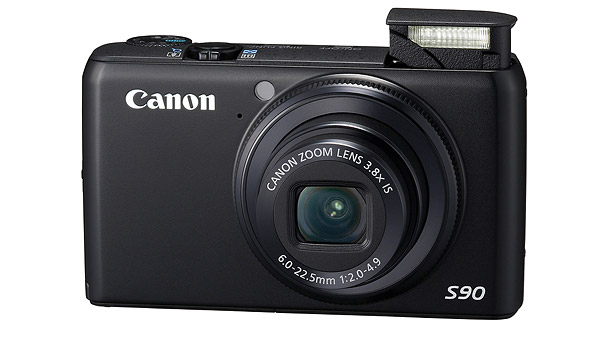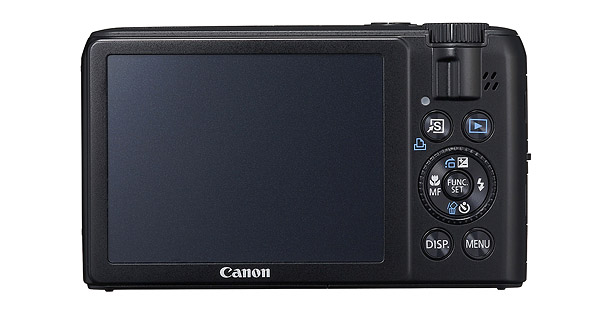Thoughts on the Return of the S-Series
by Laurence Chen
 Apparently Canon has decided to re-enter the fray and stop watching Panasonic and Ricoh eat up the “pro-features-in-a-compact” market. Or maybe this is just wishful thinking getting the better of me, yet again. Nonetheless we have a potentially killer RAW-capable, 28-105mm, low-noise compact to look forward to from Canon. Canon’s new PowerShot S90 digital camera packs all the latest techno-goodness into a stylish, compact, all-black package. And have you noticed how, well, Leica-like the styling is? I’m sold on that, at least!
Apparently Canon has decided to re-enter the fray and stop watching Panasonic and Ricoh eat up the “pro-features-in-a-compact” market. Or maybe this is just wishful thinking getting the better of me, yet again. Nonetheless we have a potentially killer RAW-capable, 28-105mm, low-noise compact to look forward to from Canon. Canon’s new PowerShot S90 digital camera packs all the latest techno-goodness into a stylish, compact, all-black package. And have you noticed how, well, Leica-like the styling is? I’m sold on that, at least!

Here are the details: The new Canon PowerShot S90 offers a new 10-megapixel sensor with a “dual anti-noise system” (see “High Sensitivity System” in the Canon PowerShot G11 article here), an image-stabilized 3.8x, 28-105mm f/2.0-4.9 zoom lens, RAW format, a 3-inch LCD display and a customizable, lens-perimeter control ring.
The most notable physical feature here is the new control ring whose function can be set by the user to adjust a variety of settings. More on this in a moment.
Canon PowerShot S90 Key Features and Specs:
- New 10 megapixel “high-sensitivity” sensor
- RAW format
- DIGIC 4 Processor
- ISO 80-3200
- 28-105mm f/2.0-4.9 zoom lens with OIS optical image stabilization
- New customizable control ring
- “Dual Anti-Noise System”
- 3.0 inch LCD with improved color rendition and 461,000 pixels
- Enhanced i-Contrast
- Improved scene detection
- New Low-light mode
A reading of the S90′s overall feature specs doesn’t suggest anything revolutionary. In fact, it seems predictably ordinary, with the notable exception of the lower megapixel-count sensor. Canon is to be applauded for hearing the clamor for better high-ISO image quality, despite the somewhat belated response. As most people know, image quality at ISO 400 and above is a weak spot with compact cameras.
To this end, the new 10 MP sensor is designed for minimal noise (lower resolution means bigger pixels and lower noise) and image files are tweaked with Canon’s new DIGIC 4 processor to further reduce noise. It’s being marketed as a “dual anti-noise system.” Call it what you like – all we care about is how it looks at ISO 400 and higher. A clean file at ISO 800 and a useable ISO 1600 would be a significant step forward.
There is a new “Low Light” mode that reduces resolution to 2.5 megapixels at ISO speeds of up to ISO 12,800 at 2.4 frames per second. I’m not sure how useful this will be but perhaps there are applications for this kind of low-resolution speed. (Uploading your kid’s soccer action shots to Flickr or Facebook, perhaps?)
On the zoom lens side of the exposure equation, it’s wonderful that Canon put a fast aperture of f/2.0 on the wide end of the lens. That will likely run up to f/4.9 pretty fast (my guess is that the 35mm focal length equivalent will be about f/3.5 or f/3.7). For a compact camera, this is a reasonable trade off even though we all want a constant f/2 throughout the whole zoom range (next to impossible). Speaking of the zoom range, the 28-105mm is a very useful, real-world shooting zoom range. The competition, the Panasonic Lumix LX3, has a wider zoom but cuts things short at 60mm (35mm equivalent). For my style of shooting, this is too short and indeed, I sold my LX3 after about two months. The S90’s zoom range is very likely the sweet spot for most people.
The S90 has more smart scene technology, new i-Contrast enhancement, and white balance control. These are always welcome features for those times when you really do just want to point and shoot. And I am hearing that more and more people are indeed just relying on the built-in smarts, reserving the photo fine-tuning for those really special or tricky exposure situations.

Getting back to the customizable control ring (see above), it’s nice that it can be set to zoom the lens to the classic 28mm, 35mm, 50mm, 85mm and 105mm focal lengths. It was also a good idea to allow it to adjust exposure compensation. That got me thinking… Imagine if you could set it to adjust exposure and behave thusly:
- When you first move the dial, there is a very slight pause as a see-through exposure histogram appears onscreen with the image (which you can still see) behind it. The image itself automatically goes into highlight-warning mode and flashes the overexposed portions of the frame. Maybe the image could switch to monochrome and the highlights go magenta or something. Either way, you could immediately see a precise illustration of your exposure.
- Then when you turn the dial, you can see the histogram move and the highlight warning change dynamically as the exposure changes.
- When you stop/release the dial the picture returns to normal with exposure set to exactly what you want.
I think this could be, dare I say, a revolutionary way of setting a camera’s exposure. (And I’m sure I’m NOT the first person to think of this.) Plus, this could be done with a dial or even on a touch screen, which might be even more slick.
While exposure usually doesn’t change much once you’ve set it in the real world, this kind of real-time exposure feedback would still really help photographers get the kind of look they want from a scene. And if you’re a RAW shooter, this helps you better fine-tune your exposures for post-processing.
So perhaps Canon will deliver a revolutionary product before this Christmas. But even if they don’t, the PowerShot S90 promises a strong return for Canon to the RAW-capable “prosumer” compact marketplace.
With all the marketing, it’s easy to forget that the essence of a photographer-friendly camera has not changed in years and years: fast shutter response, fast shot-to-shot speed, and consistently fast, accurate auto-focus (at all zoom lengths). These “features” remain to be seen, and I am cautiously optimistic given Canon’s recent history.
The new Canon PowerShot S90 should be in stores and available from online dealers in October. The suggested retail price for the S90 is $429.99.
Official Canon PowerShot S90 Press Release >>
About Laurence Chen
Laurence Chen is a freelance editorial photographer and writer based in Seattle, WA. His clients have included Saveur, Fortune, Sunset, and America 24/7. He is an adjunct professor of photography at Seattle Pacific University and he writes a column for Popular Photography and Imaging. Digital camera buyers can find advice in his e-book, “Take Control of Buying a Digital Camera”, at http://www.takecontrolbooks.com/buying-digicam.html.
Related Content:
Canon Cameras And Accessories User Reviews
Canon Cameras Forum
All Canon News And Articles
Canon Web Site




I have mixed feelings about this one. I owned an S30, S40, S50, S70, and an S80, and was sad to see the line be dropped. I’m happy to see it come back, as the series were a great compromise between portability and control. I’m not happy to have yet another great new camera to consider when I go looking for my next purchase.
Thanks for your comment, Kanga. I agree it’s good to see the S-Series coming back. However, I am finding my own personal feelings mixed. I have a lot of confidence that the image quality of the new camera will be great – possibly even groundbreaking. However, image quality has come far enough in the past 3 or so years that I’ve become more interested in the little pocket superzooms like Canon’s SX200 IS or the Panasonic Lumix ZS3. The Panasonic in particular interests me as it has great 720p video as well as a 12x zoom. I think the new S90 is the camera I wanted two years ago. Unfortunately, I am discovering that I may have moved on. I’m now willing to trade a little image quality for more flexibility.
Manual controls on this Canon S90 looks just great , I agree.
I also agree with ‘Photo-John’ that the focal range of the lens might be limiting the cameras versatility -
after all, it’s a “take-anywhere, anytime”-sized camera, so you wish for a broad focal range to match as many situations as possible.
The thing that appeals to almost all “prosumer” (wannabes´), is precisely those manual controls :
-” Yes, you know, I tweaked the shutter speed so I would get just the right amount of motion blur, you see … ”
In other words, they can claim “I was the one who did it”.
So logically, this neat little camera certainly will get lots of fans.
But honestly, in talented hands a good automatic camera can produce smashing pics of comparable quality.
In my book, point-and shoots suffer a major drawback: they LACK A REAL VIEWFINDER.
I’d gladly sacrifice the display alltogether for a high quality electronic viewfinder ! A big, high resolution display could ( should ) be separate, you could use some of the newer mobile phones, an iPod, a netbook or else, when you “have to” share your pics on the go.
The camera would be cheaper, smaller, have longer battery life, and – most important – offer REAL versatility when shooting in strong ambient light or other severely difficult conditions.
A versatility that would match a long-zoom lens ! A proper eye-piece would greatly aid reviewing, too.
Any takers ?
For my style of shooting and seeing, I’ll trade off zoom range for faster apertures within reason. The focal length range of 28-105mm is a classic range from the 35mm film days, but I’d prefer either 24-120mm or 28-160mm or 28-200mm with the long end being f/4 if possible.
Panasonic is definitely pushing the envelope, but the LX3′s post-processing compensation for the lens’ optical distortions was a pain in the rear for me shooting RAW. (And I preferred my Lumix LX1′s size and in-hand feel and handling over the LX3.)
I see Ken Rockwell just wrote a rave about the S90, and he is a big fan of the SD880 IS (I concur and own one too). As I said, I’m cautiously optimistic that this camera will nail the mix of DSLR-like features I’ve been waiting oh so long for. Sure a wider zoom range would’ve been nice, but I’m ready to replace my LX1 if the image quality and handling performance of the S90 add up to more than the sum of the parts… the best cameras just get out of your way so you are free to create.
When the S80 vanished into the ether so many years ago, I had to rethink what my next camera would be. The s90 could be amazing, but stopping the line diverted me into the dSLR world, so too late for me. Too bad about the lack of optical viewfinder, but those days have passed..
Does anyone know if the S90 will have optical zoom while in the video mode. I believe the new G11 does, would be great if the S90 did as well.
It’s Oct 15, 2009 and my friend just picked up his S90 last night. Glazer’s in Seattle got four of them and they were all spoken for… Me, I have to wait my turn and I’m way at the back of a certain online retailer’s list. Boo-hoo.
Initial impression: ISO 800 looks great for a compact. Image sharpness is up there too. Auto W/B seems respectable, again for a compact and perhaps particularly for a Canon. The sample shots he sent me have the Digic 4 “look” – that texture if you know what I mean – but it’s much less objectionable in a compact than, say, a 7D. But it’ll probably never show up in a print! (ha ha). Build quality is nice – not metal but not plasticky, he says.
Jury is still out on things like AF speed/accuracy/consistency and shot-to-shot speed and overall W/B and RAW file quality and exposure quality/consistency, but that’s just because he has only had the thing since 8 pm last night. Canon doesn’t have a problem in these areas, BTW, I just mention them as they’re the things we’ll be evaluating from here on out.
Anyway, my friend predicts Canon will sell a few boatloads full of these gems, so get yours before the holiday rush depletes inventory. And incidentally, his Lumix LX3 is up for sale…
Good shooting folks – looks like we finally have the compact we’ve been asking for!